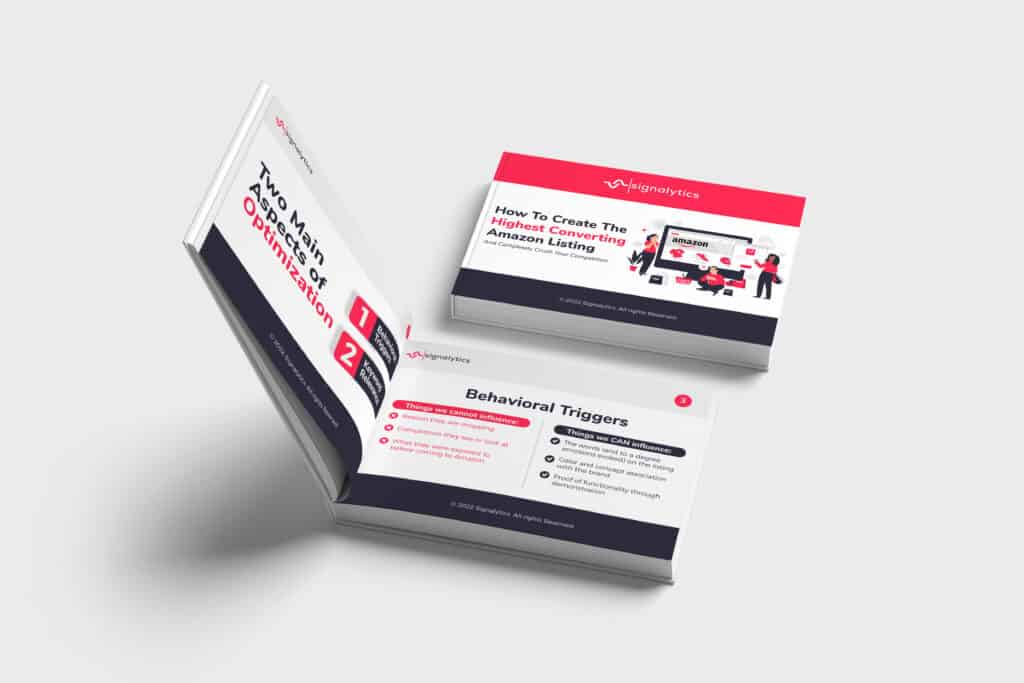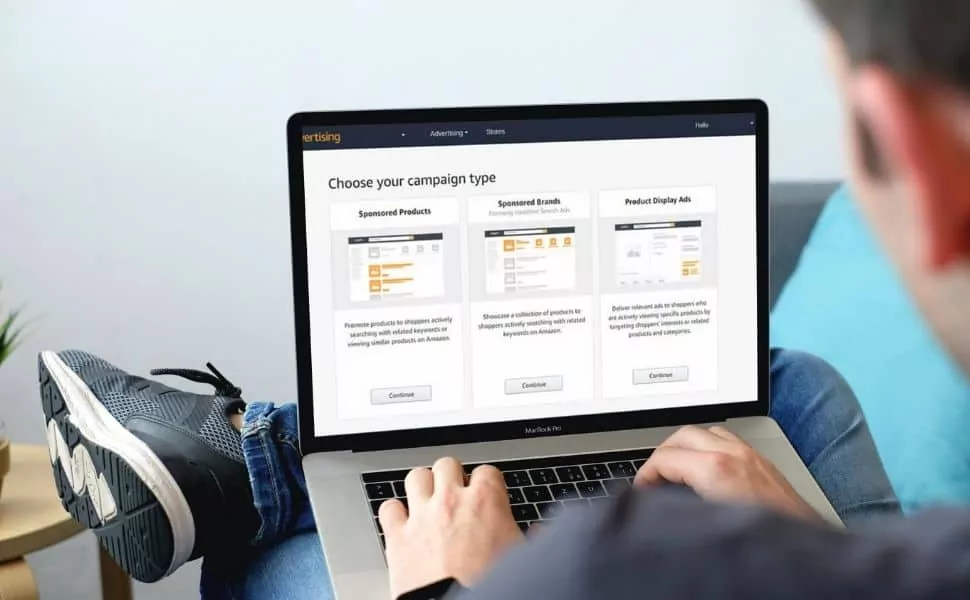With the pandemic seemingly behind us, every Amazon seller will be looking to cash in this coming 2022.
If running an Amazon PPC campaign is in your plans, then you’ll need to read this post to the very end.
In this article, we’ll share Amazon PPC tips to help separate yourself from the pack. That way, you can generate more sales and cultivate a positive ROI.
Before we get to that, we’ll start by ironing out a few things. Let’s get started.


Get Our Internal Amazon Listing Optimization Operating System and increase conversions by 18%+ HERE 👇
What is Amazon PPC?
Amazon PPC is the biggest advertising platform on Amazon. As the name suggests, you pay for clicks on your ads. The idea is to enable you to close a sale.
As a seller, your job is to bid on how much you’re willing to spend for your product to pop up if a prospective buyer searches as a specific term.
If your product ad pops up and the customer clicks on it, you pay Amazon for this service.
PPC campaigns bring sellers a lot of advantages throughout their Amazon selling journey.
It increases traffic leading to your listing and improves your product’s visibility in a wider range of audiences, possibly resulting to more sales.
PPC ads can also help your listing realize a visibility during special selling seasons like Amazon Prime Day, Black Friday Sale, and holiday seasons. This is also beneficial for new product launches so it gains traction.
Some of the best things about Amazon PPC is giving you flexibility and control depending on your ad goals.
You can choose to automate some processes to save time, or, manually control certain elements like budgets and keyword variations.
Campaign performance is also tracked using data-based metrics that allow you to see if it is working to your advantage. It can assist you as well with your decision-making when it comes to marketing strategies, product improvements, etc.
There are various strategies you can implement depending on your purpose. Thus, it is important to have a firm understanding of how PPC campaigns work.
There are three types of Amazon PPC formats.
- Sponsored Products – There are keyword-focused ads. They allow you to sell or promote a particular product based on ASINs and keywords.
- Sponsored Brands – These ads allow brands to leverage Amazon’s logo, headline, and three of their products. They also direct customers to the brand’s page when they click on them.
- Product Display Ads – These ads direct a prospective buyer to a product’s detail page on Amazon. Product display ads are ideal if you use interest and customer targeting to deliver relevant ads to prospects who are more likely to buy the item.
Where Do Amazon Ads Appear?
Now that you know what Amazon PPC is and the various types of ads, let’s look at where they’ll appear on a website.
- Sponsored Products – These ads appear on the search and product detail pages. You can also find them on external websites.
- Sponsored Brands – These appear on the search results page. This package offers four ad placements, with one appearing on the top fold while the other three pop up below the fold.
- Product Display – These appear right below the “Add to Cart” button on the Amazon product detail page. You can also find a product display ad on the right side or at the bottom of the search results page.
Leveraging Amazon PPC for Organic Ranking
It is important to mention that Amazon PPC sales don’t necessarily translate to a better product organic ranking.
However, if your ads generate more sales, your product’s organic ranking will increase because Amazon links your product to the converting keyword terms.
High organic ranking through PPC is beneficial for newly listed products. Due to the fact that these products have not started to generate sales, leveraging PPC can be an excellent strategy to increase your product’s visibility.
Tips to Grow Your Amazon Advertising in 2022
As the year comes to a close, it is time to strategize on how to make the most out of your Amazon PPC campaign. And of course, your competitors might be doing that now as well.
Amazon also now welcomes more visuals in the product listing. Thus, there are more ways to capture and convert prospects to customers. It is time to step up your creative juices and make sure to exhaust your advertising opportunities.
ACOS remains to be a strong indicator of success for PPC campaigns. And with long-term strategizing and implementation in mind, a higher return of investment is expected for sellers.
Advertising in Amazon is also getting a lot more dynamic. You can now integrate more visuals and interactive elements. Just make sure to follow the image guide and general guidelines to avoid Amazon from taking down your ads.
That said, we have shared the tidbits below to help you achieve your goals.
Combine Manual and Automatic Targeting
Like any other advertising platform, you’ll want to be in charge of every aspect of your Amazon PPC campaign. That way, you can make crucial decisions such as how much to spend from the point of information.
Expect an increase in spending because of increased competition in the platform. Average CPC is also higher now.
Still, you’ll want to use automatic features for tasks such as keyword research. By automating your target campaigns, you can test the market to discover the keywords prospective buyers use to find products like yours.
So in 2022, set up an automatic target campaign and allocate a minimum budget since you’ll use it to test the water.
Allow the campaign to run for a few days and analyze the results to determine which search terms customers used to land on your ads. Then, use these as your keywords for your manual campaign.
While you shouldn’t use this tactic to replace keyword research tactics such as Google Planner, it can come in handy if you want to add value and optimize your results.
Leverage Match Types
You’ll want to blend these match types to achieve an ultra-targeted campaign enabling you to reach the maximum number of customers likely to buy. Think of it as a way to help you cast your net as wide as possible.
You can add the words in front, middle, or after your target keywords. While this is the least targeted match type, it can help you kickstart your campaign and unearth valuable keywords in the process.
In addition, matching phrases enables you to narrow down the searches that land on your ads. With this strategy, you’ll add words in front of your keywords. Be sure to include misspellings and plurals.
Include Target Keywords in Your Product Listings

There’s one thing you should aim for with your Amazon PPC campaign in 2022, and that’s giving the best user experience possible. You can achieve this by providing relevant results for any search. So, ensure that your ads don’t appear where they’re not wanted.
In order to make sure that your ads are not popping up just about anywhere, you’ll want to add target keywords in the copy of your product listings. Still, make sure you’re tactful. Otherwise, prospective customers may not be able to read your listings, which by extension, can lower your conversion rate.
Organize Your Campaign
You’ll need to organize your Amazon PPC campaign if you want to save money and achieve positive results.
Running an unorganized campaign will lose you money and attract unqualified clicks perpetuated by the use of wrong keywords. On top of that, you’re likely to overspend on clicks, leading to a negative ROI.
Organizing your campaign shouldn’t be hard. First, you’ll need to select good products and use related keywords.
Moreover, you can organize your campaign by category, top sellers, and brand. Remember, products within the same category may generate different margins, implying that your products can’t have the same bid.
So, be strategic in your bidding based on a product’s performance and margin.
Using the right tools can help increase the success rate of your campaigns. They can help you group campaigns accordingly and monitor their performances. Just as long as these tools are updated to the latest Amazon algorithm, then you are on track.
Use Negative Searches to Control Your Ads
You can block your Amazon PPC ads from showing for specific searches aided by negative keywords.
For instance, if you sell jackets but don’t stock leather jackets, you can add leather jackets as a negative keyword. That way, you’ll prevent the keyword from showing for searches related to jackets.
Therefore, a prospective customer will land on your ad when searching for jackets but will not come across your ad when searching for leather jackets.
Remember that every click comes with a cost, and you would want to turn that into a sale as much as possible.
You can create your negative keyword list over time. Even so, if you have a particular keyword that you want to block, you can add it right away before seeing any performance results.
As a rule of thumb, be sure to check your keywords periodically to discover more negative keywords.
Set Your Bids According to Performance and Value
As stated, different products have different profits margins. It makes perfect sense then to avoid bidding the same amount for all your keywords.
The idea is to avoid losing money in products with low profits. Put differently, the more valuable a keyword is in terms of ROI, the higher the bid.
In addition, choose keywords related to low-profit items to help lower their bid depending on your target advertising cost of sale. After all, your primary goal is to earn a profit, not to lose money or break even.
However, it is important to note that for new campaigns, you may need to set a higher bid to accumulate a search history.
Amazon tends to prefer senior competitor campaigns with a proven track record of generating sales. Once you have a search history and sales, you can regulate your bidding process.
Zero-In Prospects with Long Tail Keywords
For starters, long-tail keywords are more specific phrases about a search term. In most cases, a long-tail keyword combines three or more keywords.
For example, if you sell steel toe boots, a potential long-tail keyword would be steel toe boots for women. This will only make sense if you sell such steel-toe boots.
Long-tail keywords can ensure that your keywords appear for more relevant searches, increasing your chances of higher conversions.
A good thing about long-tail keywords is that they aren’t as expensive to bid on just like vague ones. Yet, this variation can help you capture more leads.
Leverage Data to Boost Conversions
Sure, the Amazon advertising platform doesn’t have the best user interfaces. However, if you know how to use it, you can discover hidden insights to help you optimize your workflow and pinpoint the best opportunities to enhance your PPC campaign.
Start by downloading your search term report to enable you to discover the keywords driving customers to your ads.

The frequency may vary depending on the size and maturity of your campaign. You may need more frequent analysis to generate enough data and drive results for a new campaign.
You will then organize your data into an easy-to-follow report while picking search terms that aren’t performing well. Also, you’ll want to analyze your keyword bids, match types, and long-tail keywords.
Aside from keyword analysis, you also need to prepare the landing page – the product listing. Make sure that it is optimized for converting keywords and at the same time, engaging and informative for your prospect customers.
If the product listing is optimized, you are increasing the chances of conversion. And you have to bear in mind that you are writing not just for the algorithm but also the human mind. Level up the listing by adding allowed media elements and applying the principles of copywriting.
Allow Your Campaign Enough Time To Mature
Indeed, it might take several weeks for your Amazon PPC campaign to start bearing results. You’ll need to be patient before optimization begins.
Leverage settings like budget caps to help you stay within your budget as you wait for the results to trickle in.
Key indicators to look out for include keyword bids and impressions. Make sure that you allocate enough money to your ads to get impressions. Without an adequate budget, your ads won’t pop up as many times as required and will therefore fail to generate conversions.
As stated, your bid amounts may vary depending on the target cost of sales and the profit margins of different merchandise.
Once you’ve narrowed down the most valuable optimization strategy, tweak your variables one at a time, and wait for a few days to analyze the results. We recommend using the A/B testing strategy to determine if changes drove the expected impact.
Master and Leverage Amazon PPC Today
Amazon PPC is a tested and proven strategy to improve sales and boost revenue in the marketplace.
And, given the ever-growing competition on Amazon, it is becoming a requirement for any seller that wants to rank in substantial profits.
And if you won’t do PPC, then someone in your competition will.
As you prepare to launch your Amazon PPC campaign in 2022 and to the world, Signalytics can offer a helping hand.
Our services are packaged to help your make the most of your business, whether you’re looking to run an Amazon PPC campaign or optimize your listings.

